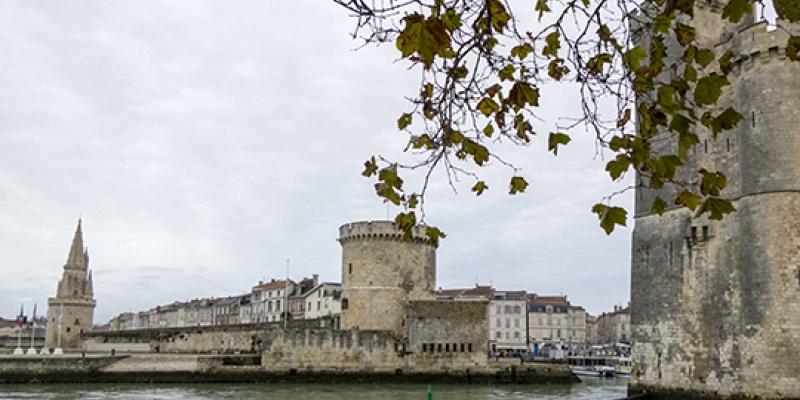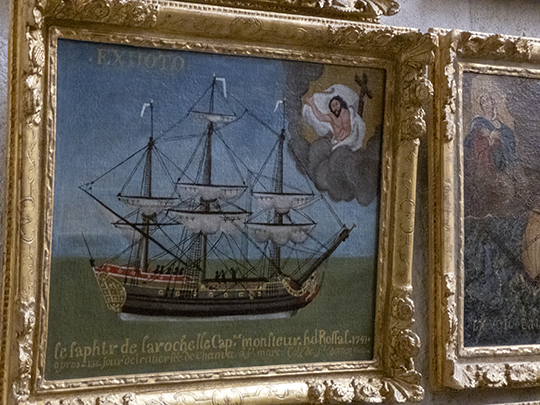
Thursday, December 12th, 2024
Our Visit to La Rochelle - Part 2
Cover image: Medieval towers at the Old Port of La Rochelle
© Entrée to Black Paris
Read Part 1 of this blog post here.
On Wednesday morning, we left our hotel in the northwest corner of La Rochelle's Old Town and walked the route indicated by our hotel's staff to the city's visitor's center.
We were impressed by the stone arches that lined the streets of the town and marveled at the scores of sailboats docked at the Vieux Port (Old Port).
 Stone arches
Stone arches
© Entrée to Black Paris
 The old port
The old port
© Entrée to Black Paris
Arriving at the visitors' center, we met a lovely woman named Marie-Agnès, who served as our guide. She began the tour by showing us a huge aerial photograph of La Rochelle on a wall at the center. She explained the layout of the city and pointed out the various ports that serve the city today. She told us that during our tour, we would see the Old Port, the one that was implicated in the slave trade.
With this geographical orientation in mind, we set out for our walk.
A couple of minutes after leaving the tourist office, we saw the first of several street signs that recall La Rochelle's involvement in slavery and the slave trade (see image below).
 Rue de l'Armide street sign
Rue de l'Armide street sign
© Entrée to Black Paris
The English translation of the information on this sign is as follows:
"In 1749, the ship Armide was outfitted for the slave trade by Pierre Gabriel Admyrauld. Armide is a Muslim sorceress, a character from Jerusalem Delivered by the Italian poet Tasso."
These commemorative signs were installed by the city, which has publicly recognized its involvement with slavery and the trans-Atlantic slave trade for almost 40 years.
During the tour, we visited two churches that drove home the importance of these activities to the city.
Eglise Saint Sauveur had two ex-voto installations of slave ships on the walls.
 Ex-voto ship at Eglise Saint Sauveur
Ex-voto ship at Eglise Saint Sauveur
© Entrée to Black Paris
Cathédral Saint-Louis had a chapel devoted to sailors, complete with a stained-glass window depicting a ship and several paintings representing slave ships.

Chapelle des Marins - stained glass
© Entrée to Black Paris
Marie-Agnès took special care to describe the history of Le Saphir (The Sapphire), one of the ships portrayed here. Owner Elie Giraudeau named his slave ships after precious stones. In 1737, The Sapphire left La Rochelle for the coast of Guinea in West Africa, where European goods were traded for captives. The ship subsequently set sail for the island of Saint-Domingue (Haïti). There, the captives were sold for goods (predominantly partially processed sugar) that were brought back to France.
 Ex-voto painting of Le Saphir
Ex-voto painting of Le Saphir
© Entrée to Black Paris
A street sign in the Old Town commemorates this vessel.
What we saw in these houses of worship clearly demonstrates how the denizens of La Rochelle sought God's blessing for slaving activities.
We visited two streets where sugar refineries operated and learned that producing refined (crystalized) sugar in Saint Domingue was forbidden. Molasses (the syrup formed at the beginning of the sugar-making process) was what was exported from Saint Domingue to France. La Rochelle's refinery owners took this syrup and further processed it to produce refined sugar, which they sold in France and throughout Europe to expand their wealth.
On rue de l'Escale, a narrow road partially paved by stones, a refiner's home stood next to his storage facility at Number 24.
 Rue de l'Escale
Rue de l'Escale
© Entrée to Black Paris
 Residence and adjacent storage facility
Residence and adjacent storage facility
© Entrée to Black Paris
Another refinery existed across the street at Number 23.
 Former sugar refinery
Former sugar refinery
© Entrée to Black Paris
Marie-Agnès told us that the black paving stones in the street had been brought to La Rochelle from Senegal. They had been used for ballast for the returning ships.
 Black paving stones from Senegal
Black paving stones from Senegal
© Entrée to Black Paris
From rue de l'Escale, we walked through Square Jacques Rasteau to rue Gabriel Admyrauld. Across the street from the square, we found the entrance to the rear courtyard of the Tribunal du Commerce.
 Rear entrance to the Tribunal du Commerce
Rear entrance to the Tribunal du Commerce
© Entrée to Black Paris
A carefully manicured garden flanks the path between the rear courtyard and the main courtyard, which is graced with bas relief and haut relief maritime-themed sculptures by Levasseur. Among these are depictions of two ship sterns with animals on deck that evoke the companies operating in Guinea and Senegal.
 Main courtyard of the Tribunal du Commerce
Main courtyard of the Tribunal du Commerce
© Entrée to Black Paris

Bas relief by Levasseur
© Entrée to Black Paris
 Haut relief representing the Guinea Company
Haut relief representing the Guinea Company
© Entrée to Black Paris
Slave ship owners planned expeditions and conducted transactions at the Chamber of Commerce. Chamber directors were appointed directly by the king. Activity began during the reign of Louis XV and continued under Louis XVI.
After our thought-provoking walk through Old Town La Rochelle, we were primed for our visit to the Musée du Nouveau Monde. Come back next week to read about it in Part 3 (the final part) of this article.

 Our Walk: Black History in and around the Luxembourg Garden - Click here to book!
Our Walk: Black History in and around the Luxembourg Garden - Click here to book!